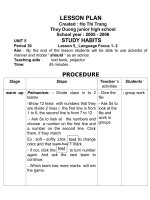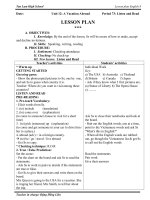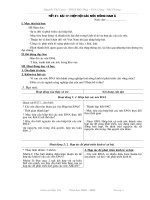- Trang chủ >>
- Văn Mẫu >>
- Văn Biểu Cảm
english 8 period 21
Bạn đang xem bản rút gọn của tài liệu. Xem và tải ngay bản đầy đủ của tài liệu tại đây (132.64 KB, 8 trang )
<span class='text_page_counter'>(1)</span>Week: 21 Period: 61. Date of preparation: 11/01/2013 Date of teaching: 15/01/2013. UNIT 9: A FIRST – AID COURSE LESSON 4: READ. I. OBJECTIVES: By the end of the lesson, students will be able to: - Know some first – aid situations such as: fainting, shock, and burns. - Develop reading skill. II. PREPARATIONS: Book III. PROCEDURES: Teacher’s activities Students’ activities 1. Warm – Up: (5’) - Ask students to take turns to make and respond to - Pair works. requests, offers and promises with the pictures given. 2. Pre – Reading: (5’) - Write. - Explain new words: 1. lie flat (v) 6. revive (v) 2. force (v) 7. overheat (v) 3. elevate (v) 8. minimize (v) 4. lower (v) 9. tissue damage (n) 5. victim (n) - Ask students to match the first-aid correctly (Handouts) - Group works. Case : FAINTING __ SHOCK __ BURNS First-aid: a. Cool the burns immediately so as to minimize tissue damage. b. Don’t force him/ her to sit or stand. c. Don’t give the victim any food or drink. d. Ease pain with ice or cold water packs. e. Don’t give the victim drugs or alcohol. f. Elevate the patient’s feet, or lower his/her head below the level of the heart. g. Give the victim a cup of tea when he/ she revives. h. Leave the patient lying flat. i. Put the affected part under a running cold tap (If possible). j. Cover the burned area with a thick sterile dressing. k. Don’t overheat the victim with blankets or coats. l. Don’t let the victim get cold. - Ask students to give feedback. - Give feedback. - Ask questions to elicit the grammar point..
<span class='text_page_counter'>(2)</span> Why should we cool the burn immediately? We should do it so as to / in order to minimize the tissue damage. - Have students practice the questions and answers. - Explain the grammar point: Meaning : để * Form: [ so as to / in order to + V- inf. ] * Usage: To indicate purposes. 3. While – Reading: (15’) - Ask students to read the instructions on p.83 to check their answers. - Ask students to read aloud the answers. 1. Fainting: h, b, f, l, g. 2. Shock : k, c, e. 3. Burns : a, i, d, j. - Have students read the statements on the page 84 and match three leadings to them. A. Fainting: a, c, e. B. Shock : b. C. Burns : d. 4. Post – Reading: (13’) - Ask students to read the instructions again and fill them in the grid. Case Do Don’t Fainting Shock Burns - Ask students to give feedback. 5. Homework: (2’) - Reread the instructions. - Do the exercises 3,5 /p. 56-57 (workbook). - Prepare next lesson: Unit 9 – Write/ p.83. - Individual work.. - Pair works. - Listen.. - Individual work. - Read the answers.. - Pair works.. - Pair works.. - Give feedback.. Take note.. IV. COMMENTS: --------------------------------------------------------------------------------------------------------------------------------------------------------------------------------------------------------------------------------------------____________________________________ _____________________________.
<span class='text_page_counter'>(3)</span> Week: 21 Period: 62. Date of preparing: 11/01/2013 Date of teaching: 15/01/2013. UNIT 9: A FIRST-AID COURSE Lesson 5: WRITE I. OBJECTIVES: By the end of the lesson, Ss will be able to know how to write a thank -you note. II. PREPARATIONS: book, handout III. PROCEDURES: Teacher’s activities. Students’ activities.
<span class='text_page_counter'>(4)</span> 1. Warm – Up: (5’) - Organize game: “Arranging a letter” 1/ I am looking forward to hearing from you soon. 2/ I was happy to receive your letter that you sent me on Sunday. 3/ Your friend, 4/ As you said in the letter that you liked Vietnamses dishes, I send you a packet of Vietnamese special food. 5/ Dear Tom, 6/ I hope that you like this present from Ha noi. 7/ Please write me when you receive the parcel. 8/ Nga 2. Pre – Writing: (10’) - Set the scene: ”Nga was sick and she had to go to hospital. After she left the hospital, she wrote a thankyou note to Hoa. Why and what did she write?” - Have Ss do True/ False predictions. 1. Nga writes to thank Hoa for some candy. 2. Hoa’s gift cheered Nga up. 3. Nga left the hospital on Friday morning. 4. Nga would like Hoa to see her at the hospital on the weekend. 5. Nga is bored now. 6. Nga writes the letter at the hospital. - Ask Ss to give feedback. - Explain vocabulary: + Thank sb for sth: + Cheer sb up = to make sb feel happier + Come over to (v)… : visit sb or a place - Practice new words. - Ask Ss to look at the letter on page 84 and complete the correct form of the verbs. - Call some Ss to give their answers. (1) was , (2) were , (3) helped , (4) came , (5) am , (6) will telephone. - Ask Ss to read the whole letter to check the True/ False sentences predictions. 1. F flowers. 4. F at her house. 2. T 5. T 3. F on Monday morning. 6. F at her house.. -Individual work Answer: 5 – 2 –4 – 6–7 –1- 3– 8. - Listen to the teacher. - Pair works.. - Give feedback - Listen and write.. - Practice - Pair works. - Give the answer. - Read silently and check the predictions.. - Work in individual. 3. While – Writing: (15’) - Ask Ss to write a thank – you note to a friend, using - Practice. the questions on page 85. - Call some Ss to practice asking and answering the - Pair works. questions. - Ask Ss to join the sentences into a paragraph to make a thank-you note. Suggested letter Dear …,.
<span class='text_page_counter'>(5)</span> Thank you very much for the present you sent me on my birthday party last Sunday on January 25. It was very lovely. I loved it very much. Now I am alone and feel tired from studying too much. I want to go out to enjoy the fresh air and relax my mind. Do you want to go on a picnic with me this Sunday? I’ll phone you on Saturday afternoon. I’ll come and pick you up at 7.30 am. I’m looking forward to seeing you. Your friend, (signature) 4. Post – Writing: (13’) - Call one - two students to write their letter on the board. - Correct mistakes if necessary. 5. Homework: (2’) - Write another letter to a friend for other occasions. - Prepare next lesson: Unit 9 – Language Focus/ p.86. - Write the letter on the board. - Listen. -Take note..
<span class='text_page_counter'>(6)</span> IV. COMMENTS: -----------------------------------------------------------------------------------------------------------------------------------------------------------------------------------------------------------------------------------------------____________________________________________________________________. Week: 21 Period: 63. Date of preparation: 12/01/2013 Date of teaching: 16/01/2013. UNIT 9: A FIRST-AID COURSE LESSON 6: LANGUAGE FOCUS. I. OBJECTIVES: By the end of the lesson, students will be able to review Unit 9: structure “in order to/ so as to”, future simple, and modal will to make requests, offers, promises.. II. PREPARATIONS: Book III. PROCEDURES: Teacher’s activities. Students’ activities.
<span class='text_page_counter'>(7)</span> 1. Warm – Up: (5’) - Ask students to write a thank-you note to a friend, and to invite him/ her to go on a picnic. 2. Exercises: (35’) a/ Exercise 1: In order to/ so as to - Ask students to look at the language focus 1 to do matching. - Ask students to give feedback. 1f , 2c , 3b , 4e , 5a , 6d - Have students practice asking and answering. Why do you always keep the window open? I always keep the window open so as to/ in order to let fresh air in. b/ Exercise 2: Future simple tense - Ask students to look at the dialogue to complete it with the correct word or short form. (1) will , (2) will , (3) won’t , (4) Shall , (5) will , (6) ‘ll. - Have students practice the dialogue in pairs. c/ Exercise 3: Modal will or shall to make requests - Ask students to look at the pictures and the given words to make meaningful phrases. a. open the window. d. turn on the TV. b. give it to me. e. pour me a glass of c. answer the water. telephone. f. get me the cushion. - Have students remind of the requests with “Will” - Ask students to complete the dialogues. a. Will you open the window, please? b. Will you give it to me, please? c. Will you answer the telephone, please? d. Will you turn on the TV, please? e. Will you pour me a glass of water, please? f. Will you get me the cushion, please? - Ask students to practice the dialogues. d/ Exercise 4: Modal will or shall to make requests, offers or promises. - Ask students to look at the pictures, and make requests, offers or promises with the words given in the box. - Get students to recognize the situations and ask them to say. The garbage can is overflowing. Somebody should. - Whole class.. - Pair works. - Give feedback - Pair works.. - Pair works.. - Pair works.. - Look at the picture.. - Remind. - Pair works.. - Pair works.. - Look at the picture.. -Listen and recognize the situations..
<span class='text_page_counter'>(8)</span> empty it. Will you empty the garbage can, please? - Ask students to read the answers. b. Will you paint the door, please? I will paint the door tomorrow. c. Will you study harder, please? I will study harder. d. Will you carry the bag for me, please? Shall I carry the bag for you? e. Will you hang the washing, please? Shall I hang the washing for you? f. Will you cut the grass, please? I will cut the grass for you. 3. Consolidation: (3’) Remind structure: in order to/ so as to, future simple tense and modal will. 4. Homework: (2’) - Do the exercises 5,6,7/p. 57 – 58 (workbook). - Prepare next lesson: Unit 10 - Getting stared, Listen and Read/ p. 89, 90. - Read the answer.. - Listen. -Take note. IV. COMMENTS: --------------------------------------------------------------------------------------------------------------------------------------------------------------------------------------------------------------------------------------------------------------------------------------------------------------------------------------------------------------------------_______________________________________________________________.
<span class='text_page_counter'>(9)</span>









